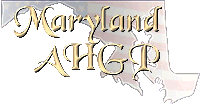Black Slaves in Maryland
It is not definitely known when and by whom the first
African Slaves were introduced into the Colony of
Maryland. In 1642 records show that Governor Calvert was
bargaining with a shipmaster for thirteen slaves at St.
Mary's. At any rate, the increase of slaves, for a
while, was not very rapidly.
But, just as they began to increase a most interesting
"question came up with respect to the effect of Baptism
administered to them, or to their offspring. It was held
by some, that the effect of Baptism, in making them
"Christians," freed them from physical bondage. That is,
on being baptized they immediately became "freemen."
This feeling, or conviction, greatly interfered with the
increase of slavery as well as with the imparting of
Christian instruction to those who had already been
imported. The question occupied the minds of the local
authorities, as well as the authorities in London. In
1671, an act was passed entitled "an act for the
Encouraging the Importation of Negroes and Slaves,''
which declared that Baptism, or Conversion, should not
be taken to give manumission in any way to their slaves
or to their issue, who had become or should become
Christians, or who had been or should be baptized,
either before or after their importation to Maryland,
any opinion to the contrary notwithstanding. In Virginia
there was enacted, in 1667 that baptism did not give
freedom, so that diverse masters, freed from doubt,
might endeavor to spread Christianity among the blacks.
By an act of 1681, children born of white women and
black men, were free. After 1692, the issue of a union
between any white woman with a slave or free black,
became; servants for a long time. A law enacted in 1715,
forbade, under penalties, the marriage of a white to any
black or mulatto slave. But, by this law a white and a
free mulatto, could marry. The law of 1717 made a free
black or mulatto, except mulattoes born of white women,
slaves for life. In the record office in London, in
1712, there was a list of "Christian" men and women and
children, and also black slaves in Maryland. According
to this list there were then, in Maryland, 38,000 whites
and 8,000 blacks. In 1790, there were over 208,000
whites and nearly half as many slaves in Maryland. Of
the 2,290 blacks imported into Maryland between 1699 and
1707, all but 126 were brought in London vessels.
It is interesting to note that from the very first there
seemed to be a goodly number of whites who were opposed
to Slavery. In various ways, this feeling and conviction
was shown. Shortly after the Revolution, 1776, a
concerted effort was made in the direction of the
abolition of Slavery, members of the Society of Friends,
or Quakers, were conspicuously in the lead. In 1785, the
House of Delegates of Maryland received a petition along
this line, and legislation was introduced to that end,
but failed of adoption. Yet, it is significant that the
members of that body voting upon the proposition were
very nearly equally divided. Two years later, the
Baltimore Yearly Meeting of Friends sent another
petition to the legislature on the subject. In 1789 the
Maryland Society for Promoting the Abolition of slaves,
and the Relief of poor Negroes, was organized.
One of the 'effects of this continued agitation was
indicated in the constant increase of manumissions. An
increasing number of whites were moved to set free their
slaves, not a few by means of their last will and
testament: and, others, were induced to permit slaves to
purchase their own freedom. In 1829 a memorial from
citizens of Frederick County, requesting the adoption of
such legislation whereby children born of slave parents
might become free at a certain time, was considered, but
not adopted. The trend of affairs generally were
contributing to a steady increase in the number of "free
Negroes," and this condition of affairs also conspired
to render more severe and cruel the lot of slaves. The
presence of "free Negroes," in itself, was a constant
inspiration to the slave to become dissatisfied with
servitude. Then, in 1831, came the news of Nat Turner's
insurrection, in Virginia, and this contributed still
more to the fears of the slave-holders, and rendered
them more watchful, and at the same time more cruel
towards the slave. Following close upon all this was the
bold attitude of William Lloyd Garrison, demanding
immediate abolition. Slave laws of the greatest
stringency followed fast upon each other. At the same
time, all of these various conditions hastened the
adoption of the "Colonization" scheme as the State
policy.
The establishment of Liberia, on the west coast of
Africa, was the logical outcome of the systematic
agitation, all along, of humane whites with respect to
the abolition of slavery which commenced soon after the
first introduction of slavery into the colony of
Maryland. As judged from the exigencies of the
situation, at the time, they esteemed it the very best
that could be accomplished, under all the circumstances,
in a merciful and humane way, for the welfare of the
enslaved blacks. So they finally got the State pledged
to Colonization as the State policy, and an
appropriation of a certain sum of money to pay the
expenses of such as volunteered to go to Africa. Many
manumissions were given with the expressed condition
that, in a reasonable time, the person set free should
leave Maryland for Africa. In 1843, a clergyman of the
Episcopal Church, of Charles county, brought a number of
slaves owned by him to Baltimore, and, himself
presenting them for Confirmation, in St. James' First
African Church, to the late Bishop Whittingham, who
administered the rite, immediately gave them their
freedom on condition that they at once leave the country
for Africa, which was done.
Maryland
Biographies| Maryland
AHGP

Source: Gazetteer of Maryland,
by Henry Gannett, Washington, Government Printing
Office, 1904.
|



